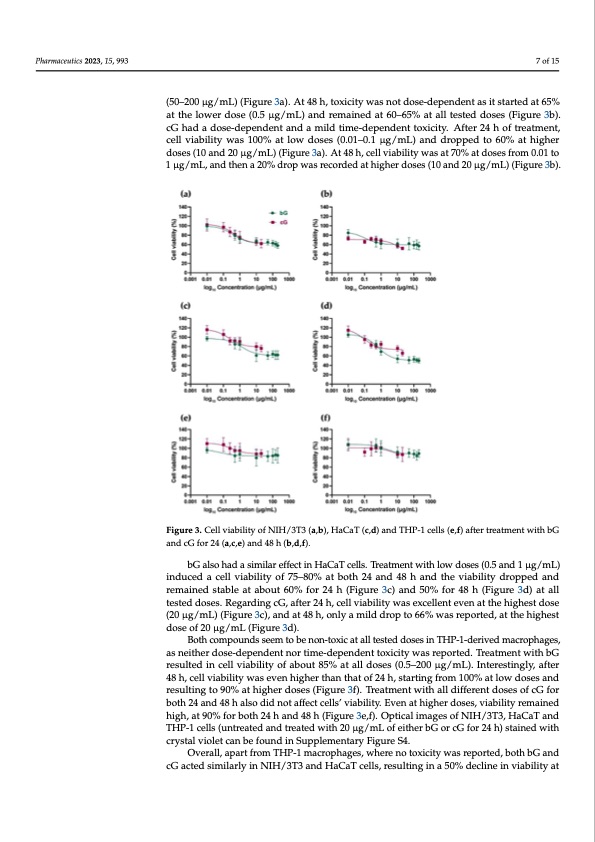
PDF Publication Title:
Text from PDF Page: 007
Pharmaceutics 2023, 15, 993 In NIH/3T3 cells, bG induced mild dose-dependent toxicity at 24 h, with cell viability starting from 80% at low doses and declining at about 60–65% at higher doses (50–200 μg/mL) (Figure 3a). At 48 h, toxicity was not dose-dependent as it started at 65% at the lower dose (0.5 μg/mL) and remained at 60–65% at all tested doses (Figure 3b). cG had a dose-dependent and a mild time-dependent toxicity. After 24 h of treatment, cell viability was 100% at low doses (0.01–0.1 μg/mL) and dropped to 60% at higher doses (10 and 20 μg/mL) (Figure 3a). At 48 h, cell viability was at 70% at doses from 0.01 to 1 μg/mL, and then a 20% drop was recorded at higher doses (10 and 20 μg/mL) (Figure 3b). (50–200 μg/mL) (Figure 3a). At 48 h, toxicity was not dose-dependent as it started at 65% bG also had a similar effect in HaCaT cells. Treatment with low doses (0.5 and 1 at the lower dose (0.5 μg/mL) and remained at 60–65% at all tested doses (Figure 3b). μg/mL) induced a cell viability of 75–80% at both 24 and 48 h and the viability dropped cG had a dose-dependent and a mild time-dependent toxicity. After 24 h of treatment, and remained stable at about 60% for 24 h (Figure 3c) and 50% for 48 h (Figure 3d) at all cell viability was 100% at low doses (0.01–0.1 μg/mL) and dropped to 60% at higher tested doses. Regarding cG, after 24 h, cell viability was excellent even at the highest dose doses (10 and 20 μg/mL) (Figure 3a). At 48 h, cell viability was at 70% at doses from 0.01 to (20 μg/mL) (Figure 3c), and at 48 h, only a mild drop to 66% was reported, at the highest 1 μg/mL, and then a 20% drop was recorded at higher doses (10 and 20 μg/mL) (Figure 3b). dose of 20 μg/mL (Figure 3d). Figure 3. Cell viability of NIH/3T3 (a,b), HaCaT (c,d) and THP-1 cells (e,f) after treatment with bG Figure 3. Cell viability of NIH/3T3 (a,b), HaCaT (c,d) and THP-1 cells (e,f) after treatment with bG and cG for 24 (a,c,e) and 48 h (b,d,f). and cG for 24 (a,c,e) and 48 h (b,d,f). bG also had a similar effect in HaCaT cells. Treatment with low doses (0.5 and 1 μg/mL) Both compounds seem to be non-toxic at all tested doses in THP-1-derived macro- 7 of 15 induced a cell viability of 75–80% at both 24 and 48 h and the viability dropped and phages, as neither dose-dependent nor time-dependent toxicity was reported. Treatment remained stable at about 60% for 24 h (Figure 3c) and 50% for 48 h (Figure 3d) at all with bG resulted in cell viability of about 85% at all doses (0.5–200 μg/mL). Interestingly, tested doses. Regarding cG, after 24 h, cell viability was excellent even at the highest dose after 48 h, cell viability was even higher than that of 24 h, starting from 100% at low doses (20 μg/mL) (Figure 3c), and at 48 h, only a mild drop to 66% was reported, at the highest and resulting to 90% at higher doses (Figure 3f). Treatment with all different doses of cG dose of 20 μg/mL (Figure 3d). for both 24 and 48 h also did not affect cells’ viability. Even at higher doses, viability Both compounds seem to be non-toxic at all tested doses in THP-1-derived macrophages, as neither dose-dependent nor time-dependent toxicity was reported. Treatment with bG resulted in cell viability of about 85% at all doses (0.5–200 μg/mL). Interestingly, after 48 h, cell viability was even higher than that of 24 h, starting from 100% at low doses and resulting to 90% at higher doses (Figure 3f). Treatment with all different doses of cG for both 24 and 48 h also did not affect cells’ viability. Even at higher doses, viability remained high, at 90% for both 24 h and 48 h (Figure 3e,f). Optical images of NIH/3T3, HaCaT and THP-1 cells (untreated and treated with 20 μg/mL of either bG or cG for 24 h) stained with crystal violet can be found in Supplementary Figure S4. Overall, apart from THP-1 macrophages, where no toxicity was reported, both bG and cG acted similarly in NIH/3T3 and HaCaT cells, resulting in a 50% decline in viability atPDF Image | Green Exfoliation of Graphene

PDF Search Title:
Green Exfoliation of GrapheneOriginal File Name Searched:
pharmaceutics-15-00993.pdfDIY PDF Search: Google It | Yahoo | Bing
Salgenx Redox Flow Battery Technology: Power up your energy storage game with Salgenx Salt Water Battery. With its advanced technology, the flow battery provides reliable, scalable, and sustainable energy storage for utility-scale projects. Upgrade to a Salgenx flow battery today and take control of your energy future.
| CONTACT TEL: 608-238-6001 Email: greg@infinityturbine.com | RSS | AMP |